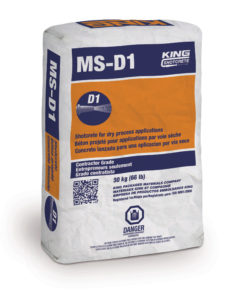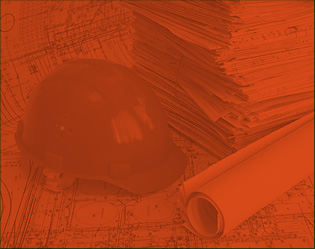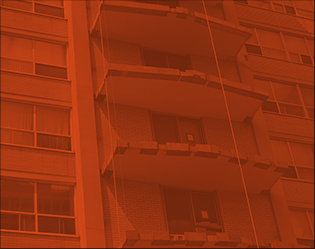Improve Your Shotcrete: Use Coarse Aggregates!
MS-D1 SY
• Air-entrainment provides superior resistance to freeze-thaw cycling and salt-scaling resistance.
• Improved adhesive and cohesive plastic properties.
• Significantly reduced rebound, resulting in lower material usage.
In the shotcrete industry, appropriate aggregate selection and specifications are often the neglected aspects of the shotcrete mixture design. Generally, people tend to rely solely on ACI 506R-05, “Guide to Shotcrete,”1 and use either the proposed Gradation #1 or Gradation #2. This is certainly a good start, but we believe a little more can be said to support the choice.
Indeed, the maximal diameter and gradation of the aggregate phase are crucial to obtain optimal properties from a given shotcrete mixture. This article is written to show and explain why the use of a coarse, well-graded aggregate phase is beneficial to the quality of the shotcrete. Although it is written especially for the dry-mix process, the principles also apply to the wet-mix shotcrete process.
Characteristics of the Optimal Aggregates
To obtain the best mixture for dry-mix process shotcrete, the first step is to select a gradation that follows ACI 506R-05, “Guide to Shotcrete,”1 Gradation #1 (mortar gradation) or #2 (coarse aggregate gradation). According to ACI 506R-05,1 the coarse aggregate size should be larger than 1/4 in. (6.3 mm). As a guideline, it is believed the best results are obtained with Gradation #2, with a maximum aggregate size of 3/8 in. (10 mm), because this is what will promote an in-place composition as close as possible to that of cast-in-place concrete.2-4 To ensure improved properties such as freezing-and-thawing resistance, alkali aggregate reaction resistance, and abrasion resistance, the aggregate quality should, at a minimum, meet ASTM C33. Although there is no standard regarding the maximum amount of elongated particles, it is safe to say that these particles should be minimized and controlled even more so than in cast-in-place concrete. These aggregates can have many negative effects on shotcrete, such as reducing the shootabilty, forcing reduced hose length (plug), and causing a more difficult finishability. Quality certificate reports for the aggregates should always, as with traditional cast-in-place concrete, be reviewed before the beginning of any project.
The Effect on Shootability and Paste Content of the In-Place Shotcrete
It is well known in the cast-in-place industry that, for a given mixture design, increasing the size of the larger aggregate increases the workability of the fresh concrete or, conversely, reduces the water demand. This effect is directly attributed to the fact that a larger aggregate gradation has a smaller amount of empty space that must be filled in by the cement paste. In dry-mix shotcrete, this either translates into a reduced water-cement ratio or improved placement and reinforcing bar encapsulation properties. In all cases, the use of a coarse aggregate gradation leads to an in-place concrete composition that is closer to that of cast-in-place concrete.
There is no point in writing a “Technical Tip” on coarse aggregates without addressing the question of rebound. It is often assumed that larger particles tend to rebound more than those found in a finer aggregate gradation. Whereas this assumption may be correct, the overall rebound values found for shotcrete mixtures with a fine aggregate gradation are comparable with mixtures produced with a coarser aggregate gradation, when both are shot at their wettest stable consistency.5 The difference, however, is that when rebounding, the larger aggregates have transferred more kinetic energy to the substrate, boosting compaction, improving encapsulation of the reinforcing bar, and increasing homogeneity of the in-place shotcrete.
In short, combined with a well-distributed gradation, larger aggregates usually generate better compaction and reduce the required amount of cement paste to an optimized level to build up a given layer of shotcrete.
Better In-Place Shotcrete Properties
In dry-mix shotcrete applications, the use of a coarse aggregate gradation reduces the in-place paste content, leaving the installed material with an increased aggregate content. If we accept the fact that the aggregates are normally the most stable component of an in-place concrete/ shotcrete mixture, we can also accept the fact that they play a very positive role on concrete durability. By minimizing the cement paste content of a given shotcrete mixture, total shrinkage is minimized, which greatly reduces the risks of cracking and bond failure at the substrate and shotcrete interface.4 Furthermore, the minimized cement paste content will also reduce the permeability and porosity of the in-place shotcrete, promoting long-term durability and improving freezing-and-thawing resistance.
Additionally, when shotcrete is chosen as a repair material, a higher content of coarse aggregate will more closely reflect that of the parent concrete, resulting in a repair material with more compatible hardened properties (for example, modulus of elasticity, coefficient of thermal expansion, and creep). This compatibility (between the repair material and the parent concrete) is a crucial factor in achieving a long-term durable repair.6
Other Aspects to Consider When Using High Dosages of Coarser Aggregates
It has been proven that the transportation of dry material through a shotcrete hose is more efficient when the mixture contains coarse aggregates. This efficiency can be attributed to the “cleaning effect” that coarse aggregates provide when traveling through the hose. The abrasion of coarse aggregate against the inside lining of the hose reduces the cement buildup and improves material flow. Consequently, in many cases, the use of a coarse aggregate gradation will allow the use of longer transportation hoses.
Application thickness is another aspect of the shotcrete process that should be considered when evaluating the gradation of shotcrete aggregates. The minimum thickness of any shotcrete application should always be a minimum of three times the maximum diameter of the largest aggregate. Taking into consideration that a shotcrete mixture containing aggregate measuring a maximum of 3/8 in. (10 mm) will often have traces of aggregate measuring 1/2 in. (12.7 mm), the minimum thickness at which this shotcrete mixture should be placed is 1 1/2 in. (38 mm).
In conclusion, the use of coarse aggregate in shotcrete mixtures will provide a wide range of benefits to both plastic and hardened properties. These benefits can be as simple as improved shootability and fewer disruptions due to plugging or as complex as reduced shrinkage and improved long-term durability. We must always remember, however, that shotcrete is simply a method of placing concrete. We would never design a cast-in-place concrete mixture without coarse aggregate. The same consideration should be given when designing a concrete mixture that is applied using the shotcrete process.







